| Pages:
1
2
3
4
5 |
DJF90
International Hazard
    
Posts: 2266
Registered: 15-12-2007
Location: At the bench
Member Is Offline
Mood: No Mood
|
|
I would set up for steam distillation and use this property of benzoquinone to advantage. Amarego and Perrin list this as one of the methods for
purification, and in your case theres very little else that should pass over.
|
|
|
JJay
International Hazard
    
Posts: 3440
Registered: 15-10-2015
Member Is Offline
|
|
Interesting... I guess you could run the steam distillation like a simple distillation and then extract the product from the distillate?
|
|
|
DJF90
International Hazard
    
Posts: 2266
Registered: 15-12-2007
Location: At the bench
Member Is Offline
Mood: No Mood
|
|
Benzoquinone is not particularly soluble in water and so should crystallise out. Just collect the distillate, cool in an ice bath to improve the
extent of crystallisation and filter to obtain the solids. If further purification is required then sublimation or recrystallisation can be used.
|
|
|
JJay
International Hazard
    
Posts: 3440
Registered: 15-10-2015
Member Is Offline
|
|
Here's the problem with that approach: There's only a small amount of benzoquinone in the reaction mixture, and I'd rather not sacrifice any to
mechanical losses. I'm also not relishing the idea of scraping benzoquinone out of my adapters, condenser, and receiver.
|
|
|
DJF90
International Hazard
    
Posts: 2266
Registered: 15-12-2007
Location: At the bench
Member Is Offline
Mood: No Mood
|
|
I don't think it poses that much of an issue, or it wouldn't be recommended.
See http://www.orgsyn.org/demo.aspx?prep=CV4P0148 for a related compound, also purified by steam distillation (note 12)
|
|
|
JJay
International Hazard
    
Posts: 3440
Registered: 15-10-2015
Member Is Offline
|
|
They did an ether extraction of the distillate (after filtering) to obtain about 20% more product. They also extended the steam distillation longer
than absolutely required to flush the adapters and condenser. Of course, this would result in lower yields without doing an extraction on the
distillate.
I think the suggestion to steam distill is a good one, but I'm quite certain that it's a good idea to follow it up with a solvent extraction for the
reasons previously mentioned.
[Edited on 16-1-2017 by JJay]
|
|
|
DJF90
International Hazard
    
Posts: 2266
Registered: 15-12-2007
Location: At the bench
Member Is Offline
Mood: No Mood
|
|
You might find that by cooling the distillate in the fridge/ice bath for a few hours might make the solvent extraction unnecessary, but in the first
instance a quick extraction with ether or DCM sounds pragmatic.
|
|
|
JnPS
Hazard to Self
 
Posts: 90
Registered: 29-7-2016
Location: PA, USA
Member Is Offline
Mood: Umpolung
|
|
I followed JJay's little mini-write up for oxidizing paracetemol via KMnO4, but after extracting both portions with 3 portions of DCM the reaction
mixture didn't seem to change color/clear-up and after drying and evaporating the combined DCM layers I was left with a small lonely empty beaker  I kept my reaction mixture just in case anyone has any idea how to extract any possible
product out of it I kept my reaction mixture just in case anyone has any idea how to extract any possible
product out of it
|
|
|
JJay
International Hazard
    
Posts: 3440
Registered: 15-10-2015
Member Is Offline
|
|
I am not sure if benzoquinone will dissolve in DCM. It does dissolve in ether and chloroform.
Here I have 10.22 grams of slightly pink acetaminophen extracted from pain reliever alongside some potassium permanganate and 60 mL homemade ether.
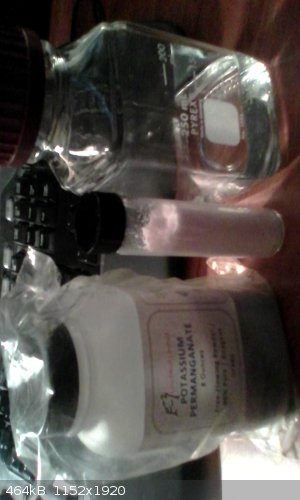
|
|
|
JJay
International Hazard
    
Posts: 3440
Registered: 15-10-2015
Member Is Offline
|
|
Quote: Originally posted by JnPS  | I followed JJay's little mini-write up for oxidizing paracetemol via KMnO4, but after extracting both portions with 3 portions of DCM the reaction
mixture didn't seem to change color/clear-up and after drying and evaporating the combined DCM layers I was left with a small lonely empty beaker  I kept my reaction mixture just in case anyone has any idea how to extract any possible
product out of it I kept my reaction mixture just in case anyone has any idea how to extract any possible
product out of it
|
There is a distinction that I probably should have drawn before... the procedure was not a "write up" - it was a proposal. A writeup should be written
in the past tense and have a reported yield. A proposal hasn't actually been tested yet.
I'm reasonably sure that it can be gotten to work. If you have some product in solution, it should be possible to extract it with chloroform,
according to the PDF from which I derived the procedure. Other solvents are untested. I am reasonably sure that ether should make a good substitute
for chloroform. From a quick search, I didn't see any solid-looking reports where anyone successfully dissolved benzoquinone in DCM, although I don't
see any theoretical reason why that wouldn't be possible. I did see one unreferenced comment made on another forum suggesting that it does not
dissolve in DCM and a few other comments stating that it does. (Note that I certainly do not possess omniscience with relation to chemistry, so there
may very well be a reason that benzoquinone does not dissolve in DCM, but I don't know what it is, if there is one.)
[Edited on 16-1-2017 by JJay]
[Edited on 16-1-2017 by JJay]
|
|
|
Metacelsus
International Hazard
    
Posts: 2539
Registered: 26-12-2012
Location: Boston, MA
Member Is Offline
Mood: Double, double, toil and trouble
|
|
I know DDQ dissolves in DCM, and I would expect benzoquinone to have greater solubility. You could probably find an exact value with some searching.
|
|
|
JnPS
Hazard to Self
 
Posts: 90
Registered: 29-7-2016
Location: PA, USA
Member Is Offline
Mood: Umpolung
|
|
Thanks for the distinction, I'll try to extract it with chloroform tomorrow, guess I finally found a use for my home-made chloroform. 
If I manage to get some benzoquinone crystals after that, I'll see if I can get them to dissolve in DCM
EDIT: I just realized @JJay, your acetaminophen is slightly pink, mine was too after extraction so I decided to recrystallize from water. I'm pretty
sure we used different brand pills so what a coincidence XD
[Edited on 16-1-2017 by JnPS]
|
|
|
JJay
International Hazard
    
Posts: 3440
Registered: 15-10-2015
Member Is Offline
|
|
I'm ready to start the reaction.
Reading over that paper again, the calculations they made to estimate the Gibbs free energy don't make sense... they calculated a positive Gibbs free
energy at 25 C, which would indicate that the reaction does not happen at that temperature... but they clearly show experimental results indicating
that the reaction does proceed spontaneously at 25 C....
The reaction clearly happens more quickly at higher temperatures, so slight heating might not be a bad idea. They have tested the reaction at
temperatures as high as 55 C.
|
|
|
JJay
International Hazard
    
Posts: 3440
Registered: 15-10-2015
Member Is Offline
|
|
When I poured in the permanganate, I could see a definite brown color of manganese dioxide forming before the solution went completely dark.
I still had a tiny amount of undissolved permanganate in my 250 ml beaker, so I rinsed it with about 10 ml of water and added it to the reaction.
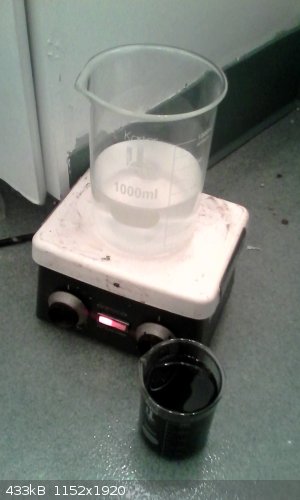
|
|
|
JnPS
Hazard to Self
 
Posts: 90
Registered: 29-7-2016
Location: PA, USA
Member Is Offline
Mood: Umpolung
|
|
I believed the delta G they were talking about was for the formation of the transition state usually denoted by a 'double dagger' symbol but they used
a hashtag instead. A positive delta G for the transition state would explain why slight heating is necessary for the reaction. I don't think they were
talking about the overall delta G for the reaction.
I had the same issue with the KMnO4, though I used around 50mL of extra distilled water to wash out the beaker. I also kept the reaction mixture
around 40C for five hours and the reaction appeared to be finished when I went to begin the work-up. Can you take a picture of your reaction mixture
afterwards? I want to see if the color of my solution matches yours.
|
|
|
JJay
International Hazard
    
Posts: 3440
Registered: 15-10-2015
Member Is Offline
|
|
I was just reading over the paper to figure out how fast the reaction should go, and I think I found a couple of errors. The units on figure 2 don't
seem to make any sense... the log of PAM<sub>0</sub>, the initial molarity of the acetaminophen, can't be positive. Surely they meant
mmol/dm<sup>-3</sup>. Also, they mistakenly refer to "dichromate" instead of permanganate on the same page as the figure.
Ignoring those obvious errors and doing some crude estimation that assumes the rate equation is first order, it looks like the half life of
acetaminophen is about 7 minutes with the initial permanganate concentration at 35 C. That means the reaction would be about 99% complete in an hour.
There are some particles of manganese dioxide floating around, but mostly, the reaction mixture just looks dark. There is a trace of an oil floating
on top of it; it looks almost like a gasoline slick. I'll take a picture, but it won't show anything very interesting....
[Edited on 17-1-2017 by JJay]
|
|
|
JJay
International Hazard
    
Posts: 3440
Registered: 15-10-2015
Member Is Offline
|
|
Whoah.. after turning off my stirrer, something interesting is happening! The manganese dioxide particles are settling to reveal a brownish/yellowish
clear solution that likely contains the product!
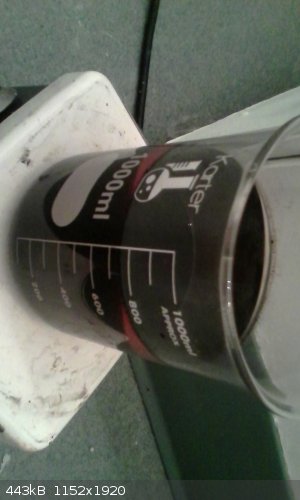 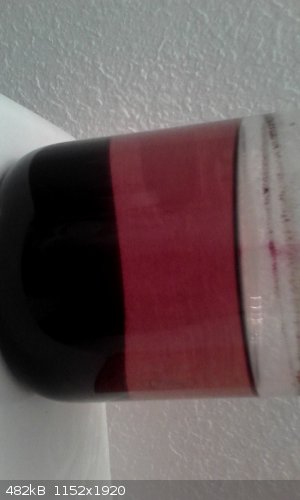 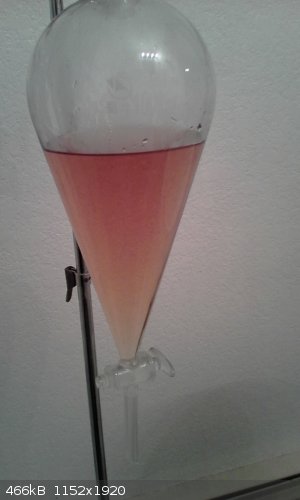
So anyway, I don't know for sure yet, but it looks pretty likely that I have some benzoquinone.
[Edited on 17-1-2017 by JJay]
|
|
|
JJay
International Hazard
    
Posts: 3440
Registered: 15-10-2015
Member Is Offline
|
|
Here's the problem I'm running into with ether: it's too soluble in water! I added 30 mL of ether to the approximately 700 mL of solution, saw two
layers form, shook it, and the top layer disappeared! If I add the entire 60 mL, I get a very small layer.
I only had 60 mL of ether, and I'm pretty reluctant to handle a larger quantity in this location, so it looks like I might have to make some
chloroform....
|
|
|
Boffis
International Hazard
    
Posts: 1867
Registered: 1-5-2011
Member Is Offline
Mood: No Mood
|
|
@JJay, yes ether is slightly soluble in water, about 3g per 100g of water, so thats why your ether layer dissolved. However, dispare not. You can
reduce this figure and the solubility of benzoquinone too by adding salt to the aqueous liquid, up to about 20g per 100ml of aqueous phase but 15g is
probably enough in your case. The addition of salt may be sufficient to salt out the benzoquinone anyway.
I tend to try methylene dichloride (dichloromethane) first because it is cheaper and more readily available but is less polar and so not a perfect
substitute.
|
|
|
JJay
International Hazard
    
Posts: 3440
Registered: 15-10-2015
Member Is Offline
|
|
@Boffis: I was seriously considering giving that a try but figured that since the reaction was so simple and the reactants are cheap there was no
point really, so unfortunately, it's in an organic waste container outside at this point and I've washed and put away my glassware... I definitely do
appreciate that suggestion, though, and I'll have to try again in the near future, perhaps tomorrow.
[Edited on 17-1-2017 by JJay]
|
|
|
JnPS
Hazard to Self
 
Posts: 90
Registered: 29-7-2016
Location: PA, USA
Member Is Offline
Mood: Umpolung
|
|
Your solution looks more red than mine does, but I don't think color differences are a huge concern. I guess I'll try salting it out first and if I
don't get any benzoquinone from that I'll just scrap my reaction mixture and try the reaction again using chloroform for the extraction.
|
|
|
PHILOU Zrealone
International Hazard
    
Posts: 2893
Registered: 20-5-2002
Location: Brussel
Member Is Offline
Mood: Bis-diazo-dinitro-hydroquinonic
|
|
Interesting to see that the protons for the oxydation comes from:
-the phenolic moeity --> phenate
-the hydrolysed acetyl group --> acetic acid
So the pink color may come from excès KMnO4, manganese(II) phenate or acetate  . .
PH Z (PHILOU Zrealone)
"Physic is all what never works; Chemistry is all what stinks and explodes!"-"Life that deadly disease, sexually transmitted."(W.Allen)
|
|
|
JJay
International Hazard
    
Posts: 3440
Registered: 15-10-2015
Member Is Offline
|
|
The solution actually wasn't pink to my eyes... more of a yellow to brown color. There was a trace of violet on the sides of the beaker from
splashing, but that was just KMnO4 and not very much of it... that stuff has an extremely intense color.
Benzoquinone is yellow and tar is brown... but perhaps pink mixed with yellow looks brown... IDK.
|
|
|
JnPS
Hazard to Self
 
Posts: 90
Registered: 29-7-2016
Location: PA, USA
Member Is Offline
Mood: Umpolung
|
|
I added 120g of salt to my 800mL of solution and It still yielded no yellow precipitate, all I filtered off was a bit of MnO2 dust that remained. I
won't be able to be in my lab again until Saturday morning, but I'll re-run the oxidation and try extracting with chloroform. I'll keep an eye on this
thread to see if JJay manages to beat me to the benzo
|
|
|
JJay
International Hazard
    
Posts: 3440
Registered: 15-10-2015
Member Is Offline
|
|
I am swamped with work tonight, but I'll definitely start on it before this weekend.
|
|
|
| Pages:
1
2
3
4
5 |